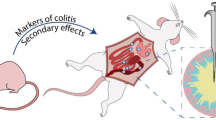Abstract.
We examined the clinical and histopathological features of the dextran sulfate sodium (DSS) induced acute and chronic colitis in rats as a model for studying basic biology of the inflamed colonic mucosa. Acute colitis was induced in male Wistar rats by 4 days (AI) or 7 days (AII) of oral 5% (wt/vol) DSS (mol. wt. 54,000) in their drinking water. Chronic colitis was induced in 8 experimental groups: CI=7 days DSS followed by 10 days water (=one cycle); CII=two cycles; CIII to CVIII (three to eight cycles) received only 4 days 5% DSS followed by 10 days drinking water. The entire colons were examined histologically; dysplasia was graded as: indefinite/probably negative for dysplasia, indefinite/probably positive for dysplasia, low-grade dysplasia, or high-grade dysplasia. The earliest clinical findings in the acute colitis group over 4 days occurred on day 2 (hemoccult positive stools, loose stools or diarrhea and weight loss). The maximal disease activity was noted on day 7 accompanied by a 53% mortality rate. The histological inflammation scores were significantly higher on day 7 than on day 4. All rats had extensive ulcerations predominantly in the rectum and cecum. The number of rats having ulcerations was markedly lower in the chronic colitis groups. The majority (75%) of the crypt lesions suspicious for dysplasia were classified as mucosa indefinite/probably negative for dysplasia. We classified 18 crypt lesions as low-grade dysplasia and one lesion as high-grade dysplasia (after eight cycles). No invasive carcinoma was observed. Most low-grade dysplasias (83%) occurred after five cycles of DSS/water, located mostly in the rectum (44%) and colon transversum (33%). Our findings suggest that the DSS colitis model in rats may be an interesting model for studying the sequence chronic inflammation-dysplasia in human ulcerative colitis. Further long-term studies with the present DSS colitis model in rats might also prove it as a reliable model to study the sequence high-grade dysplasia and colitis associated-cancer.
Similar content being viewed by others
Author information
Authors and Affiliations
Additional information
Electronic Publication
Rights and permissions
About this article
Cite this article
Kullmann, F., Messmann, H., Alt, M. et al. Clinical and histopathological features of dextran sulfate sodium induced acute and chronic colitis associated with dysplasia in rats. Int J Colorectal Dis 16, 238–246 (2001). https://doi.org/10.1007/s003840100311
Accepted:
Issue Date:
DOI: https://doi.org/10.1007/s003840100311




